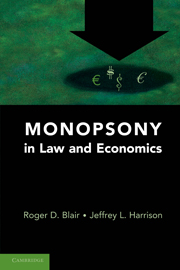Book contents
- Frontmatter
- Contents
- Preface
- ONE Introduction
- TWO The Antitrust Laws and Monopsonistic Forms of Conduct
- THREE Economic Theory of Monopsony
- FOUR The Antitrust Response to Monopsony and Collusive Monopsony
- FIVE Cooperative Buying Efforts
- SIX Bilateral Monopoly
- SEVEN Monopsony and Antitrust Enforcement
- EIGHT Monopsony in Action: Agricultural Markets
- NINE Monopsony in Action: The NCAA
- TEN Monopsony in Action: Physician Collective Bargaining: Monopoly or Bilateral Monopoly
- ELEVEN Final Comments
- Bibliography
- Index
- References
ONE - Introduction
Published online by Cambridge University Press: 05 June 2012
- Frontmatter
- Contents
- Preface
- ONE Introduction
- TWO The Antitrust Laws and Monopsonistic Forms of Conduct
- THREE Economic Theory of Monopsony
- FOUR The Antitrust Response to Monopsony and Collusive Monopsony
- FIVE Cooperative Buying Efforts
- SIX Bilateral Monopoly
- SEVEN Monopsony and Antitrust Enforcement
- EIGHT Monopsony in Action: Agricultural Markets
- NINE Monopsony in Action: The NCAA
- TEN Monopsony in Action: Physician Collective Bargaining: Monopoly or Bilateral Monopoly
- ELEVEN Final Comments
- Bibliography
- Index
- References
Summary
Introduction
Technically, monopsony exists when there is but one buyer of a well-specified good or service. Thought to be rare, until recently monopsony received scant attention in most antitrust casebooks and texts. This changed somewhat in the 1990s and, as a result of a recent decision addressing monopsony conduct by the U.S. Supreme Court, monopsony has been thrust into the forefront of consideration by antitrust academics and lawyers. This is as it should be because monopsony is far more prevalent than many have recognized. Consider the following examples: The owners of professional football teams agree on which players each team will have the exclusive right to negotiate with; the National Collegiate Athletic Association (NCAA) regulates both the number of athletic scholarships and the amount of compensation that the athletes can receive; financial aid officers of elite colleges and universities meet to avoid a bidding war for the most desirable students; tuna canneries in California allegedly fix purchase prices at artificially low levels; and antique dealers rig the bids in public auctions and then divide the spoils later. In all of these instances, the parties were exercising monopsony power in one way or another. What follows are more detailed examples of the forms the monopsonistic conduct has taken and a look forward to the plan of this book.
Bid Rigging at Antique Auctions
Many antique auctions have been plagued by the formation of auction pools, which are groups of buyers who agree among themselves not to bid against one another. Although auction pools or buyer rings are considered to be unsavory, they have been seen as customary and even inevitable at antique auctions. In spite of the obviously anticompetitive purpose and effect of auction pools, many of the participants are quite proud of their pooling activity. Cox quoted one pool member as saying “the day I was allowed to go into the pool was a banner day.” Another reported that he considered his first invitation to pool as a “mark of distinction.” We discuss antique auctions as an example, but pools have been discovered in auctions for timber rights, real estate, used commercial equipment, and such mundane items as burlap, cattle, scrap metal, sewing machines, and tobacco.
- Type
- Chapter
- Information
- Monopsony in Law and Economics , pp. 1 - 15Publisher: Cambridge University PressPrint publication year: 2010
References
- 29
- Cited by



